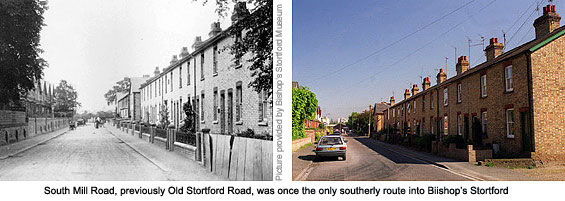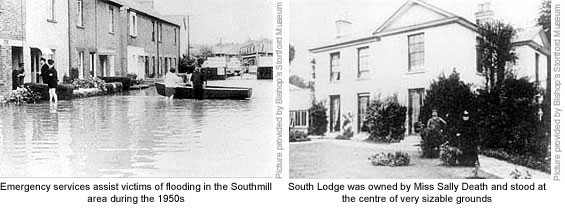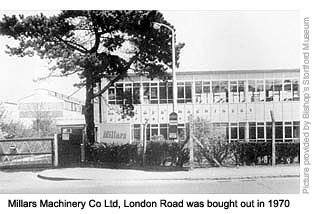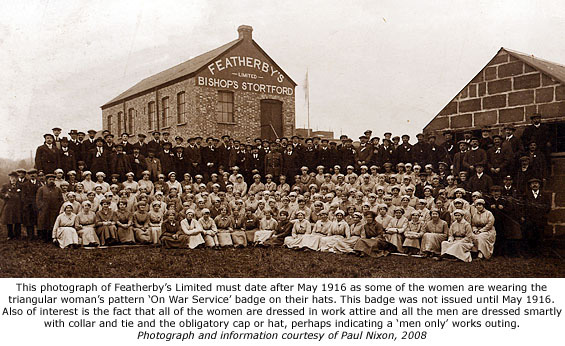|
|
|
 |
|
|
|
|
|
|
|
Twyford Road
|
|
Lined with late 19th century terraced cottages, Twyford Road lies to the east of the bridge in London Road and runs parallel with the original course of the river Stort. Beyond these houses is a small industrial estate.
This area was originally part of north-east Thorley, but in 1910 an area of 80 acres of land, centred on Twyford Road, was transferred to the civil parish of Bishop's Stortford. It had been Thorley's most densely populated area containing 59 houses and 244 persons. Further changes to the town's boundary in the 1930s took more land from the parish, the new boundary running parallel with, but south of, Thorley Lane.
|
|
|
|
Southmill Road
|
|
 |
|
|
|
Before the opening of the Hockerill bypass in the 17th century, all traffic entering the town from the south had to use the winding and often hazardous Old Stortford Road – long since straightened out and renamed Southmill Road. Its present junction with London Road was the most likely site of Maple Cross, one of four roadside crosses that once defined the town’s medieval boundary (See Guide 5 - Roadside Crosses). A cross here would certainly have informed travellers of the southern entrance to the town, but the name 'Maple' has no known links.
Crosses served many purposes, one of which was as a burial place for those not permitted burial in consecrated ground. In 1923 a coffin was unearthed in a former garden here that once ran down to the river. Two metres long and in good condition, locals were convinced the remains found inside were that of a highwayman who had been executed at the spot of the cross. The more sceptical, however, suggested that as this had been a favourite spot for gypsies to camp some hundred years previous, it was more likely to be the remains of a gypsy. Unfortunately we will never know.
 In the last century this area's close proximity to the river often resulted in serious flooding. Such occurences are now rare here but many locals still remember the early 1950s when residents had to be rescued from their water-logged homes by the emergency services and taken to safety at Elmhurst in Windhill. No doubt the builder of terraced houses on the eastern side of Southmill Road was also aware of the regular flooding here, and with tongue planted firmly in cheek named them Southsea Terrace. Also aptly named is Mill Road that leads to the former site of South Mill. In the last century this area's close proximity to the river often resulted in serious flooding. Such occurences are now rare here but many locals still remember the early 1950s when residents had to be rescued from their water-logged homes by the emergency services and taken to safety at Elmhurst in Windhill. No doubt the builder of terraced houses on the eastern side of Southmill Road was also aware of the regular flooding here, and with tongue planted firmly in cheek named them Southsea Terrace. Also aptly named is Mill Road that leads to the former site of South Mill.
Small business units make up nearby Millside Industrial estate, adjacent to which are recently built houses individually named South Lodge and South Lodge Cottages. Both take their names from the original 19th century houses that stood here – South Lodge and South House. The once sizable grounds of South Lodge would, today, encompass the sites of nearby Oxford House, the petrol station, and the Driving Test Centre in South Road. In 1775 the Barge public house opened for business near here but was pulled down in 1800 – possibly to make way for the building of South Lodge.
Maple Cross may well have been the medieval boundary marker between Stortford and Thorley, but early last century the boundary between the two was defined by the junction of South Road and London Road, known then as White Posts. The white posts in question were joined by chains and enclosed the grassed area in front of the original Oxford House – the current office block named Oxford House standing on the same site. The significance of the white posts seems to have been nothing more than ornamental.
The triangular shaped site also forms the intersection of South Road and London Road and was also referred to as 'Two Ways', a name that was later taken by a garage built here in the early 1900s. Much later the site was taken over by Ford car dealer Gates, who built a new garage on the site and named it Two Ways Garage. The name remained until Gates moved from the site and the present petrol station was built in 1999.
|
|
|
|
 |
|
|
|
London Road continues southwards in a gradual ascent, with Twyford Close on the left leading to the former site of Thorley Works – now a light industrial estate. Fronting London Road at this point is Thomas Tredgold House, a 1960s style office block originally built and owned by Millars Machinery Co Ltd.
This site was first developed in 1902 by general and hydraulic engineers, Featherby's Ltd, a company founded in 1898 by Harry Featherby after he took over the engineering workshop in Apton Road of *George Ingold – hydraulic engineer, artesian well sinker and pump-maker.
*George Ingold: born 4 October 1832, died 31 May 1899
 During World War I, Featherby's played an important role in the war effort: workers here installing fuses into 20lb Stokes aerial bombs that were then transported by road to Woolwich Arsenal in London. But the firm didn't do quite so well after the war, the Recession of the early 1920s forcing them into voluntary Liquidation, and in 1922 Thorley Works was bought by Millars Machinery. They produced cement mixers and tarmacadam plant, and having their own iron and brass foundry were called upon in World War II to help with the production of tanks for the military. During World War I, Featherby's played an important role in the war effort: workers here installing fuses into 20lb Stokes aerial bombs that were then transported by road to Woolwich Arsenal in London. But the firm didn't do quite so well after the war, the Recession of the early 1920s forcing them into voluntary Liquidation, and in 1922 Thorley Works was bought by Millars Machinery. They produced cement mixers and tarmacadam plant, and having their own iron and brass foundry were called upon in World War II to help with the production of tanks for the military.
A large and popular employer of local people for nearly 50 years, Millars was bought out in 1970 by the Enfield building machinery group, Braham, Patterson & Behan, but closed within a few years. The works buildings were then demolished to make way for Twyford Light Industrial Estate, but the office building in London Road remained and has since accommodated various businesses.

On the western side of London Road is Bishop’s Stortford Boys High School, built in 1957. Since that time it has maintained a first class academic record, but perhaps the least known fact about this school is that on the night of Friday 22 October 1957, Vincent Wright and his band played here to became the first ever Rock band to perform in Bishop’s Stortford. What happened to them after that date is anybodys guess!
Pig Lane leads to Twyford House and Twyford Mill, both of which are covered in the Thorley section.
|
|
|
|
South Road
|
|
Constructed in 1834 and funded by the Hockerill Highway Trust, South Road was created to bypass the hazardous and often flooded Old Stortford Road (now Southmill Road). Its route across fields previously used for grazing cattle, rejoined Southmill Road (as it does now) just north of the museum. The only other houses here at that time were South Lodge and South House.
Two years after the road was opened it became the scene of an event that created one of the town’s foremost legends. Between 1824 and 1841, Henry Gilbey (See Guide 4) regularly drove his coach and horses from the George Inn at North Street to the Bull Inn at Aldgate, London. In summer the journey was reasonably quick and pleasant, but in winter the weather was likely to delay journey times.
On the night of 26 December 1836, one of the heaviest snowstorms ever recorded in this country struck while Henry Gilbey was returning from London. He did well in the atrocious conditions to reach the outskirts of Stortford but at midnight, halfway along this road, his team of horses lost their battle against the deepening snow. Managing to unharness them, Gilbey then led passengers and horses home and left the coach to its fate.
His epic journey caught the imagination of one local scribe who penned the following verse:
|
|
|
|
 |
|
This poem was presented to Walter Gilbey when he became a baronet in 1893. It is now in the museum's Gilbey Collection.
|
|
|
|
Hold fast; was the word, as the rugs were withdrawn
From the backs of a good useful team.
And dull was the light of the lanterns that morn,
For the falling snow thickened their gleam,
St. Michael's proclaimed the hour to be five,
When GILBEY adjusted the reins,
And prepared for a terrible coarse cold drive
Long before the commencement of trains.
Chorus: Then hurrah for the road, a good team and good whip,
The greeting attached to the wayside 'nip'.
And in memory drink, though they may have been slow,
To the Old Stortford Coach days of GILBEY and Low.
The snow had been falling the whole night long;
The roads were all covered so deep,
That only a team that was plucky and strong
Could stick to it where it was steep.
And in places all hands had to shoulder the wheel,
Which they did with an earnest good will;
'Tis the noble true heart which for others can feel
That helps up a difficult hill.
Then hurrah for the road, etc.
So onward they tugged with a resolute mind,
For the cattle a strain and a pull,
Till London was reached a little behind
Their time at the famed 'Aldgate Bull'.
There was no better inn for Sterling good cheer,
If you searched the Metropolis through;
So with appetite keen, forgetting past fear,
To breakfast, they all buckled to.
Then hurrah for the road, etc.
When business was done, and the clock had struck four,
ANN NELSON'S they left in good form;
All had faith in their pilot to battle once more
with the pitiless withering storm.
So forward they went, but wretchedly slow,
The horses were fretting in foam;
'Twas such frightful hard work to get through the snow
That they thought they would never reach home.
Then hurrah for the road, etc.
What a wild dreary night when they reached Buckhurst Hill,
To face that long forest road;
But there's mostly a way if there's only the will,
And pluck always lightens the load.
So they strove with their might, for their hearts were all right,
when they found the old coach sticking fast;
They all lent a hand when they came to a stand.
And through many such dangers they passed.
Then hurrah for the road, etc.
Thus they tugged and they toiled as true Britons can;
What a help was that passenger power;
'Twas a struggle for horses as well as for man
To keep moving at three miles an hour.
But they never lost nerve, so they pegged on their way
Till within a short mile of the town;
And 'The Old Stortford Coach' made a record that day
Which won for its Driver renown.
At the start of World War I, over 20,000 troops were stationed in and around the town (See Guide 4 -Windhill), their many hundreds of horses stabled at local inns and on open land. Camped in fields alongside South Road were the Royal Staffs Yeomanry with over 400 of their horses tethered on ropes beside the road. On three consecutive nights they stampeded and ran for miles in all directions, but on one of these occasions they galloped headlong into the wide ditch that once divided Stortford and Thorley near to Thorley Lodge. Forty of the horses trampled each other to death. Conscientious objectors were immediately suspected of stampeding them but it was never proved.
|
|
|
|
[ BACK TO TOP ] |
|
|
|
|
|
|
|
|
|





 In the last century this area's close proximity to the river often resulted in serious flooding. Such occurences are now rare here but many locals still remember the early 1950s when residents had to be rescued from their water-logged homes by the emergency services and taken to safety at Elmhurst in Windhill. No doubt the builder of terraced houses on the eastern side of Southmill Road was also aware of the regular flooding here, and with tongue planted firmly in cheek named them Southsea Terrace. Also aptly named is Mill Road that leads to the former site of South Mill.
In the last century this area's close proximity to the river often resulted in serious flooding. Such occurences are now rare here but many locals still remember the early 1950s when residents had to be rescued from their water-logged homes by the emergency services and taken to safety at Elmhurst in Windhill. No doubt the builder of terraced houses on the eastern side of Southmill Road was also aware of the regular flooding here, and with tongue planted firmly in cheek named them Southsea Terrace. Also aptly named is Mill Road that leads to the former site of South Mill. During World War I, Featherby's played an important role in the war effort: workers here installing fuses into 20lb Stokes aerial bombs that were then transported by road to Woolwich Arsenal in London. But the firm didn't do quite so well after the war, the Recession of the early 1920s forcing them into voluntary Liquidation, and in 1922 Thorley Works was bought by Millars Machinery. They produced cement mixers and tarmacadam plant, and having their own iron and brass foundry were called upon in World War II to help with the production of tanks for the military.
During World War I, Featherby's played an important role in the war effort: workers here installing fuses into 20lb Stokes aerial bombs that were then transported by road to Woolwich Arsenal in London. But the firm didn't do quite so well after the war, the Recession of the early 1920s forcing them into voluntary Liquidation, and in 1922 Thorley Works was bought by Millars Machinery. They produced cement mixers and tarmacadam plant, and having their own iron and brass foundry were called upon in World War II to help with the production of tanks for the military.